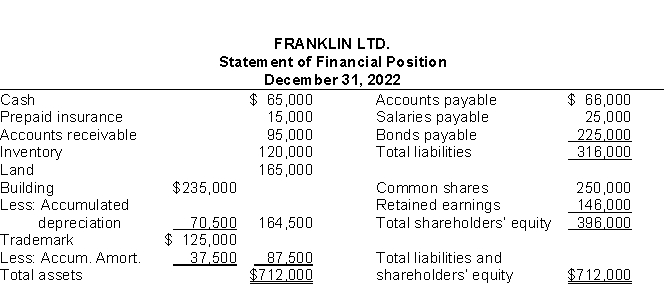A) relevance
B) timeliness
C) understandability
D) comparability
Correct Answer

verified
Correct Answer
verified
True/False
The cost basis of accounting states that assets and liabilities should be recorded at their cost not only when originally acquired, but also during the time the entity holds them.
Correct Answer

verified
Correct Answer
verified
Multiple Choice
The measurement principle that says assets are reported at the price that would be received if the item were sold is called
A) fairvalue.
B) historical cost.
C) materiality.
D) going concern.
Correct Answer

verified
Correct Answer
verified
True/False
A conceptual framework is still under development for companies using International Financial Reporting Standards (IFRS).
Correct Answer

verified
Correct Answer
verified
Multiple Choice
Use the following information to answer questions
 -The total dollar amount of assets to be classified as net property, plant, and equipment is
-The total dollar amount of assets to be classified as net property, plant, and equipment is
A) $329,500.
B) $164,500.
C) $252,000.
D) $235,000.
Correct Answer

verified
Correct Answer
verified
Multiple Choice
The current ratio
A) is calculated by dividing total assets by total liabilities.
B) takes into account the composition of current assets.
C) takes into account the composition of current assets and current liabilities.
D) is calculated by dividing current assets by current liabilities.
Correct Answer

verified
Correct Answer
verified
True/False
Intracompany comparisons are based on comparisons with competitors in the same industry.
Correct Answer

verified
Correct Answer
verified
Multiple Choice
A short-term creditor is primarily interested in the ___ of the borrower.
A) liquidity
B) profitability
C) comparability
D) solvency
Correct Answer

verified
Correct Answer
verified
Multiple Choice
The going concern assumption assumes that the business
A) will be liquidated in the near future.
B) will be purchased by another business.
C) is in a growth industry.
D) will remain in operation for the foreseeable future.
Correct Answer

verified
Correct Answer
verified
Multiple Choice
Office equipment is classified on the statement of financial position as
A) a current asset.
B) property, plant, and equipment.
C) shareholders' equity.
D) a long-term investment.
Correct Answer

verified
Correct Answer
verified
True/False
A liability is normally classified as a current liability if it is to be paid within the coming year.
Correct Answer

verified
Correct Answer
verified
True/False
The debt to total assets ratio measures the percentage of assets financed by creditors rather than shareholders.
Correct Answer

verified
Correct Answer
verified
Multiple Choice
In general, standard setters require that most assets be recorded using historical cost because
A) fair values may overstate assets and equity.
B) fair values may not always be representationally faithful.
C) cost often cannot be verified.
D) cost values may or may not be relevant.
Correct Answer

verified
Correct Answer
verified
Multiple Choice
Which of the following is not considered a measure of liquidity?
A) current ratio
B) working capital
C) both current ratio and working capital
D) debt to total assets
Correct Answer

verified
Correct Answer
verified
Multiple Choice
What is the difference between intracompany and intercompany comparisons?
A) Intracompany comparisons are based on comparisons with a competitor in the same industry, while intercompany comparisons cover two or more periods for the same company.
B) Intercompany comparisons cover two or more periods for the same company, while intracompany comparisons are based on comparisons to average ratios for the industry that a company operates in.
C) Intracompany comparisons are based on comparisons to average ratios for the industry that a company operates in, while intercompany comparisons are based on comparisons with a competitor in the same industry.
D) Intercompany comparisons are based on comparisons with a competitor in the same industry, while intracompany comparisons cover two or more periods for the same company.
Correct Answer

verified
Correct Answer
verified
True/False
Solvency ratios measure the short-term ability of the company to pay its maturing obligations.
Correct Answer

verified
Correct Answer
verified
Multiple Choice
The qualitative characteristic that says the value of information should exceed the cost of preparing it is called
A) relevance.
B) understandability.
C) cost constraint.
D) verifiability.
Correct Answer

verified
Correct Answer
verified
Multiple Choice
Use the following information to answer questions
 -The dollar amount of net property, plant and equipment is
-The dollar amount of net property, plant and equipment is
A) $ 80,000.
B) $180,000.
C) $210,000.
D) $350,000.
Correct Answer

verified
Correct Answer
verified
Multiple Choice
Use the following information to answer questions
 -The dollar amount of current assets is
-The dollar amount of current assets is
A) $ 26,000.
B) $ 40,000.
C) $ 25,000.
D) $196,000.
Correct Answer

verified
Correct Answer
verified
Multiple Choice
Use the following information to answer questions
 -The total obligations that have resulted from past transactions are
-The total obligations that have resulted from past transactions are
A) $ 20,000.
B) $ 40,000.
C) $ 96,000.
D) $170,000.
Correct Answer

verified
Correct Answer
verified
Showing 81 - 100 of 129
Related Exams